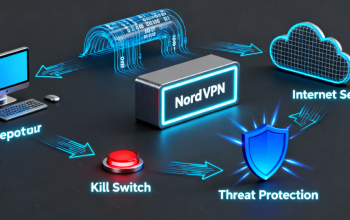In the modern internet landscape, Deep Packet Inspection—commonly known as DPI—has become one of the most controversial yet powerful technologies used by Internet Service Providers (ISPs), governments, and enterprises. It sits quietly in the background of our digital communications, examining packets of data as they traverse the network. While DPI is indispensable for optimizing traffic, maintaining security, and enforcing policies, it also plays a central role in detecting, throttling, or blocking Virtual Private Network (VPN) connections. Understanding how DPI functions, why it is used, and where its technical limitations lie offers crucial insight into the ongoing tension between privacy, performance, and control in the global internet ecosystem.
What Exactly Is Deep Packet Inspection?
At its core, Deep Packet Inspection is a form of advanced network packet analysis that goes far beyond traditional firewalls or routers. Whereas conventional network filtering looks only at the packet headers—information like IP addresses, ports, or protocol types—DPI examines the payload, or the content inside the packet. This allows network devices to make more sophisticated judgments about what the data represents: whether it’s streaming video, a VoIP call, an encrypted VPN tunnel, or even a specific application like BitTorrent or Zoom.
Technically speaking, DPI operates on the OSI model’s layer 7, the application layer, and sometimes layers below it. It involves real-time packet capture, reassembly of fragmented packets, and protocol decoding. DPI engines can analyze packet sequences to reconstruct higher-level sessions and identify behavior patterns that are characteristic of particular applications or protocols.
The Role of DPI in Modern Networks
For ISPs, DPI serves multiple legitimate and practical purposes. It helps enforce Quality of Service (QoS) by prioritizing latency-sensitive traffic such as video conferencing over bulk downloads. It enables intrusion detection systems (IDS) to recognize malicious patterns and detect security threats like malware signatures or data exfiltration attempts. Enterprises deploy DPI to enforce data loss prevention policies or ensure compliance with internal regulations.
However, DPI’s capabilities can also extend to traffic shaping and censorship. By identifying specific protocols or payloads, network operators can throttle bandwidth-intensive applications, restrict access to certain websites, or, in some jurisdictions, block VPN connections altogether. This dual nature—simultaneously protective and restrictive—makes DPI one of the most debated tools in modern network governance.
How ISPs Detect VPN Traffic
To understand how ISPs use DPI to detect VPN traffic, it helps to first recall how VPNs work. A VPN encapsulates and encrypts user data within a secure tunnel between a client and a remote server. This tunnel hides the contents of the communication and often masks the true destination of the traffic. From an ISP’s perspective, all it sees is a continuous flow of encrypted packets going to a single IP address.
Because the payload is encrypted, ISPs cannot read the underlying content. Instead, DPI systems rely on metadata, statistical patterns, and handshake characteristics to infer whether a connection belongs to a VPN.
Protocol Fingerprinting
Each VPN protocol—such as OpenVPN, IPsec, L2TP, or WireGuard—has a unique handshake or communication pattern. For example, OpenVPN often uses SSL/TLS negotiation sequences, while WireGuard uses fixed-length encrypted UDP packets. DPI engines build fingerprint databases that match these sequences. When a new connection displays a pattern matching an entry, it is flagged as VPN traffic.
Port and Header Analysis
Many VPNs operate on well-known ports (e.g., UDP 1194 for OpenVPN, UDP 51820 for WireGuard). DPI can easily identify traffic using these ports. Even if users configure VPNs to run over port 443—the same port as HTTPS—DPI still examines packet timing, packet size distribution, and TLS extensions to distinguish genuine HTTPS traffic from encrypted VPN tunnels.
Statistical and Behavioral Analysis
When protocols are obfuscated or tunnel over common ports, DPI resorts to statistical techniques. For instance, VPN traffic tends to exhibit more uniform packet sizes and consistent timing intervals compared to normal web browsing, which has varied content and bursty patterns. Machine learning algorithms can detect these subtle differences, classifying traffic as likely VPN-based with reasonable accuracy.
TLS Fingerprinting (JA3 and JA3S)
A relatively modern technique involves fingerprinting the TLS handshake between client and server. Even though the payload is encrypted, the client’s handshake parameters—cipher suites, extensions, and supported versions—form a unique fingerprint (known as JA3 for the client and JA3S for the server). If a VPN client consistently presents a fingerprint not typically associated with mainstream browsers, DPI systems can identify it as VPN-related.
Why DPI Detection Isn’t Perfect
Despite its sophistication, DPI is not omniscient. It faces inherent technical and operational limitations that make VPN detection a probabilistic, rather than definitive, process.

Encryption and Evolving Protocols
Modern encryption protocols are designed to make traffic analysis increasingly difficult. The widespread adoption of TLS 1.3 and Encrypted Client Hello (ECH) in HTTPS connections, for example, hides metadata such as server names (SNI), which DPI systems used to rely on for classification. Similarly, VPN developers continuously modify handshake behaviors to resemble normal web traffic, eroding the accuracy of signature-based detection.
False Positives and Collateral Blocking
When DPI flags traffic incorrectly, it can block or throttle legitimate services. For instance, cloud gaming streams or enterprise remote access tools can mimic VPN-like patterns. Blocking these inadvertently can disrupt users and create backlash for ISPs. Maintaining an up-to-date and accurate classification model is resource-intensive and error-prone.
Resource and Performance Costs
Real-time inspection of high-throughput networks requires enormous processing power. As DPI rulesets expand to cover new protocols, they demand higher memory, CPU, and storage resources. Scaling DPI for nationwide ISPs or hyperscale data centers can cost millions annually, which limits how extensively it can be deployed or updated.
Adaptive and Encrypted Tunnels
VPN providers sometimes use adaptive transport modes that dynamically alter packet behavior based on network conditions. These adaptive patterns confuse classifiers trained on static traffic models. Furthermore, the proliferation of QUIC (HTTP/3)—which operates over UDP and is encrypted end-to-end—makes it even harder for DPI to differentiate between standard web traffic and encrypted tunnels.
The Ethical and Policy Debate Around DPI
DPI doesn’t exist in a vacuum—it lives at the intersection of technology, regulation, and ethics. For every argument in favor of DPI for network security, there’s a counterargument emphasizing privacy and freedom of communication.
From a governance standpoint, DPI can help curb cybercrime, prevent spam, and ensure national security. But on the user side, DPI represents a potential invasion of privacy. When implemented aggressively, it can infringe on the principle of net neutrality—treating all data equally—by prioritizing or restricting certain content types.
Regulatory environments vary widely. In some countries, DPI is primarily a network management tool, while in others, it’s a censorship mechanism. The global debate now focuses on transparency and accountability: how can ISPs ensure DPI is used responsibly without overstepping ethical or legal boundaries?
Technical Countermeasures and the Arms Race of Obfuscation
While this article avoids describing evasion methods, it’s important to understand the technical dynamics of the ongoing arms race between DPI detection and traffic obfuscation. Each advancement in DPI precision tends to provoke a corresponding advancement in traffic disguise techniques—an iterative cycle of detection and adaptation.
Protocols like TLS 1.3, QUIC, and obfuscated SSH tunnels have been designed with privacy-preserving principles that indirectly make DPI’s job harder. Even so, total invisibility is elusive. Every traffic type leaves behind some statistical fingerprint—no matter how sophisticated the encryption. The key takeaway is that obfuscation and detection evolve in tandem, and absolute classification certainty remains unattainable.
DPI in Enterprise and Cloud Environments
Outside of censorship or ISP-level monitoring, DPI plays a vital role in enterprise security. Cloud providers and corporations use it to prevent data leakage, detect anomalous traffic patterns, and enforce compliance with data protection regulations. For example, a company might deploy DPI to ensure that sensitive files aren’t being exfiltrated over encrypted tunnels or that employees aren’t connecting to unauthorized VPNs during work hours.
However, as remote work expands and corporate networks integrate with consumer ISPs, these boundaries blur. Differentiating between legitimate remote access (e.g., connecting to a corporate VPN) and prohibited tunneling becomes increasingly complex, emphasizing once again that DPI is a probabilistic—not definitive—technology.
Limitations of Machine Learning in DPI
Recent advances in AI and machine learning have enhanced DPI capabilities, but they introduce new risks. Classifiers trained on biased or incomplete datasets can mislabel traffic, while adversarial examples—intentionally crafted traffic patterns—can fool AI-based detectors. The opacity of machine learning models also complicates auditing and accountability. In regulated environments, the inability to explain why traffic was blocked can pose compliance issues.
Thus, while AI-powered DPI improves accuracy, it also magnifies concerns about transparency, fairness, and error propagation.
The Future of DPI: Privacy vs. Observability
The evolution of DPI mirrors the broader evolution of the internet itself—a constant negotiation between privacy and observability. The rise of encrypted DNS (DoH, DoT), zero-trust networking, and end-to-end encryption continues to limit DPI’s visibility into user activities. At the same time, network operators seek new metrics and metadata-based approaches that preserve manageability without breaching privacy.
A growing field known as Privacy-Preserving Network Measurement (PPNM) aims to reconcile these tensions by developing analytical methods that can assess performance or detect anomalies without inspecting actual payload data. This represents the next frontier of DPI evolution—where security and privacy coexist rather than conflict.
DPI as a Mirror of the Internet’s Contradictions
Deep Packet Inspection is not inherently good or bad—it’s a mirror reflecting the priorities and contradictions of our digital age. On one hand, it secures networks, prevents abuse, and supports performance optimization. On the other, it risks eroding trust, enabling censorship, and undermining privacy. Technically, DPI’s ability to detect VPN traffic is impressive but never infallible. Encrypted protocols are evolving faster than inspection tools can adapt, ensuring that detection remains a probabilistic art rather than an exact science.

For policymakers, transparency in DPI deployment is crucial. For network engineers, understanding DPI’s mechanics helps design more robust, privacy-conscious systems. And for everyday users, awareness of how DPI functions sheds light on the invisible infrastructure shaping their online experiences. The ongoing dialogue between control and freedom, visibility and secrecy, will continue to define not only DPI’s future but the future of the open internet itself.



